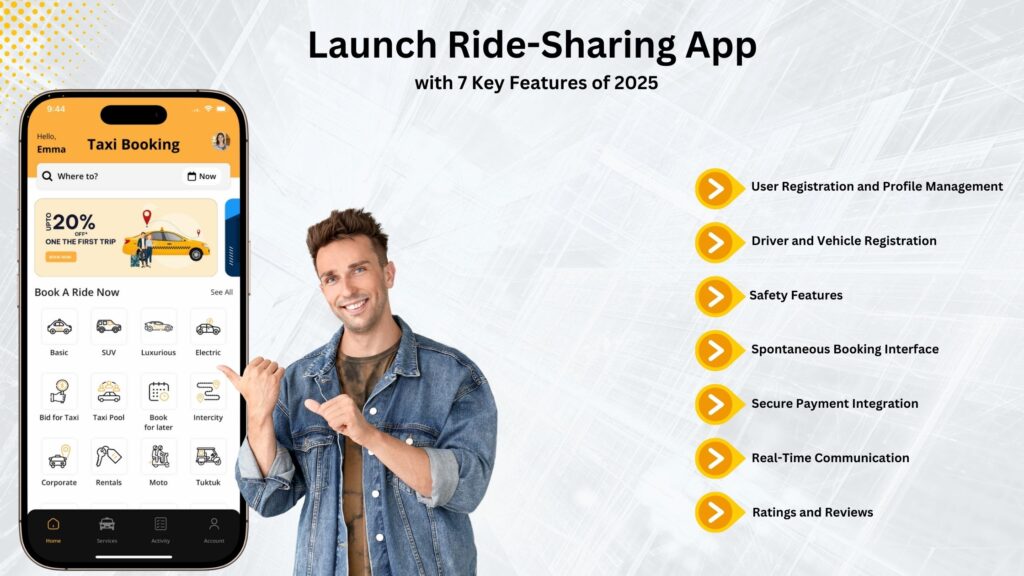Ride Sharing Apps in 2025 is changing the way people travel. Apps like Uber and Lyft have made moving across the city or cities faster, easier, and cheaper than ever before. Moreover, these apps play an important role in the growing ride-sharing market. By allowing users to book rides quickly using their smartphones and offering affordable prices, fast pick-ups, and different vehicle options.
If you are planning to build a ride-sharing app in 2025, you need to understand the key features that will make your app stand out in the market. In this blog post, explore the 7 must-have features of a successful ride-sharing application.
What is Ride Sharing?
Ride sharing means when multiple passengers share a single vehicle for their journey. Not like traditional taxis, ride-sharing apps connect drivers with passengers heading in the same direction. However, this approach allows users to divide the cost and reduce travel expenses.
Moreover, ride sharing is a perfect example of the sharing economy model. It enables car owners to offer rides to passengers for a fee, making better use of their vehicles. This model is:
- Spread out:The ride-sharing app is distributed as it enables the drivers to participate or work without being part of a large company.
- Flexible:The app is flexible enough to allow both drivers and passengers to choose when and where to share rides.
- Efficient:It maximizes the use of existing vehicles instead of requiring new ones. Moreover, it reduces the air population by letting few people travel in cars rather than different for each.
7 Must-Have Features of Ride-Sharing Apps 2025
Here are 7 very important features for your Ride Sharing App in 2025 which will help fit the competitors:
1. User Registration and Profile Management
With your ride-sharing app, make it easier for users to sign up and log in by giving the chance to them to use their email, phone number, or social media accounts. Give users control over their profiles, including payment settings, favourite locations, and accessibility needs. A user-friendly profile system will keep your customers from revisiting your app.
2. Driver and Vehicle Registration
Create a secure process for drivers to join your platform. Require them to upload important documents like driver’s license, vehicle registration, and insurance information. Moreover, do not forget to conduct background checks on all drivers. Therefore, providing the driver with a dashboard where they can manage their trips, track earnings, and view feedback.
3. Safety Features
Safety should be a top priority for any ride-sharing app. Therefore, include functions like:
- An emergency button to alert authorities or emergency contacts.
- Trip tracking those users can share with trusted friends or family.
- Driver and passenger verification systems.
By prioritizing safety, you will build trust and attract more users to your platform.
4. Spontaneous Booking Interface
Design a simple, user-friendly booking system. Let users easily enter or select their pick-up and drop-off locations. Include helpful functions like scheduling rides in advance, choosing different vehicle types, show estimating fares before booking. However, the easier it is to book a ride, the more likely users will determine your ride-sharing app.
5. Secure Payment Integration
Offer multiple payment options to cater to all users. Like credit and debit cards, direct cash payments, and in-app wallets. However, it will make sure that all transactions are secured. Moreover, provide digital receipts via email or in-app notifications. A smooth payment process will build trust with your users.
6. Real-Time Communication
Allow in-app messaging and calling between drivers and passengers. However, this feature becomes active once a ride is confirmed. Make sure these communication channels are secure and protect user privacy. Good communication tools can prevent misunderstandings and improve the overall ride experience.
7. Ratings and Reviews
Allow both drivers and passengers to rate each other after each ride. Let them write reviews based on their experience. Use their feedback to improve service quality, enhance driver performance, and ultimately build trust in the eyes of users regarding your app. Moreover, a robust rating system helps maintain high standards and keeps users coming back.
Bonus Features to Consider
To make your app stand out even more, consider adding these advanced features:
1. Analytics and Reporting
It is an essential feature for ride-sharing apps. Moreover, it involves creating a dashboard for app managers to track ongoing rides, money exchanges, and user comments. This information helps you understand how people use the app, manage finances effectively, and identify and fix problems quickly. Further, by analyzing this data, app managers can make informed decisions to improve the service.
2. Driver Choice: Accept or Reject
It is another crucial feature that empowers drivers. It shows drivers where riders are and where they want to go, allowing drivers to make informed decisions about which rides to accept. However, this feature gives drivers more control over their work, actually increasing job satisfaction and efficiency.
3. Smart Ride Matching
A sophisticated system pairs riders with nearby drivers. However, this clever system helps reduce waiting times and eliminates unnecessarily long routes. It takes into account several factors, including how close drivers are to the rider, which drivers are currently available, and current traffic conditions. Moreover, by improving these elements, the system can create a smoother, more efficient experience for both riders and drivers.
4. Plan Future Rides
It is a feature that allows users to book rides ahead of time. However, this is especially useful for daily users or those with early morning trips, such as flights. By enabling booking, your app can help users feel more secure about their transportation needs and allow for better planning on both the user and driver sides.
5. Accurate Maps
This feature is essential for any ride-sharing app. This feature uses GPS to track cars in real-time and works with map services like Google Maps to plan routes, show locations, and find the best ways to go. Good mapping features significantly improve the experience for both drivers and passengers, ensuring efficient and accurate navigation.
6. Push Notifications
Pop messages from the app keep users informed and engaged by sending updates about deals, ride status, and app news. However, this feature helps maintain open communication with users, potentially increasing user satisfaction and app usage.
7. Multiple Stops
This feature allows riders to add more than one stop on their trip. However, this is particularly useful when different people in the same car are going to other places. Users can add stops both when booking the ride and during the journey, adding flexibility to the service. However, this feature can make the app more attractive for group rides or users running multiple errands.
Hence, these insights will help you make intelligent decisions and continuously improve your Ride Sharing App.
Conclusion
While developing a ride-sharing application in 2025, you must include a mix of essential and innovative features. Focus on user experience, safety, and facilitating operations in ways that would make your application stand out in the competitive ride-sharing market.
Remember, improvement is a chain reaction process. Listen to your users, keep yourself tuned to technology trends, and always find ways to make your service better. Besides, with the correct set of features and a commitment towards excellence, your ride-share app is sure to be the most sought-after by any people in the ride-sharing market.



